| Article ID | Journal | Published Year | Pages | File Type |
|---|---|---|---|---|
| 9654541 | Robotics and Autonomous Systems | 2005 | 20 Pages |
Abstract
Internet telerobotics has emerged in recent decade with direct control and supervisory control as the main teleoperation paradigms. Both paradigms, however, are difficult to use on applications operating in the unknown and dynamic real world, while they do not provide adequate feeling of interaction or a human-friendly control interface to human operator. This paper proposes a novel interactive control (i.e., active supervisory control) paradigm: telecommanding, which is used for Internet-based wheeled robot teleoperation. Telecommanding involves two parts: basic telecommanding using joystick commands, and advanced telecommanding using linguistic commands. Each joystick or linguistic command is designed to perform an independent task and is defined with multiple events (non-time action references), and the corresponding response functions. This event-driven mechanism enables the robot to deliberately respond to expected events while to reactively respond to unexpected events. Assisted by up-to-date media streaming technologies, telecommanding can help a novice operator to easily control an Internet robot navigating in an unknown and dynamic real world. Experiments, including an Internet-based teleoperation test over 1500Â km from Beijing to Hong Kong, demonstrate the promising performance.
Related Topics
Physical Sciences and Engineering
Computer Science
Artificial Intelligence
Authors
Meng Wang, James N.K. Liu,
